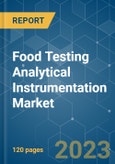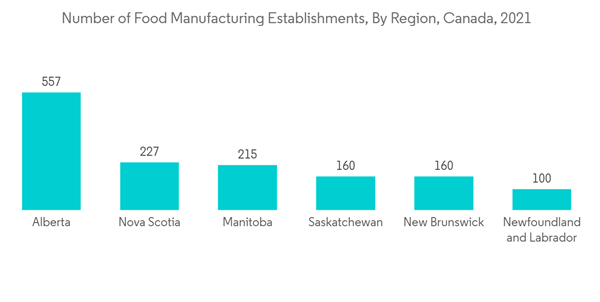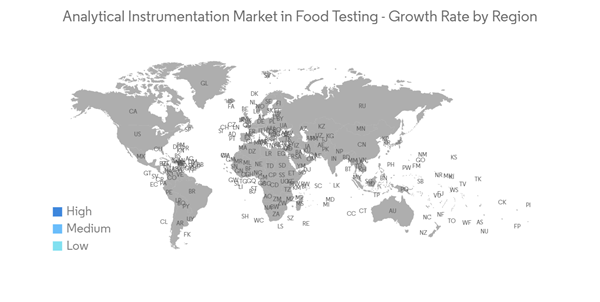Key Highlights
- The most common analytical methods used in the food and beverage industry are for monitoring and testing food safety, nutrition, and quality. These tests include chemical, microbiological, and physical contaminants to achieve compliance with local, national, and international regulations. Food contamination causes severe damage to the consumer and the brand’s reputation. The increasing investments in the food processing industry are expected to act as a major driver for adopting analytical instrumentation solutions.
- Several companies in the market are striving to advance their existing technologies and integrate new technologies to enable augmented efficiency in food testing. For instance, in February 2022, Agilent Technologies acquired advanced AI technology developed by Virtual Control, an AI and ML software developer that creates innovative and efficient analysis solutions in lab testing. Agilent may integrate the software, known as ACIES, into its gas chromatography and mass spectrometry (GS/MS) platforms to improve the productivity and accuracy of high-throughput labs served by the company globally. Several industries, such as food testing, agriculture, environmental, and applied materials, are claimed to benefit from Agilent’s acquisition of the technologies.
- Numerous companies are also launching new products to cater to the evolving and complex needs of their customers. For instance, in June 2022, PerkinElmer announced the launch of its new GC 2400 Platform, an automatic gas chromatography (GC) headspace sampler and GC/mass spectrometry (GC/MS) solution for food safety analyses intended to help technicians simplify laboratory operations, obtain precise results, and perform flexible monitoring. The platform integrates systems, software, various columns, and consumables for high-throughput laboratory environments and complex applications.
- The scope of analytical instrumentation has further expanded for food applications. Clinical diagnostic testing is emerging as a significant application as it was a considerable bottleneck during the COVID-19 pandemic. Vendors offered various solutions for the detection of COVID-19. For instance, recently, PerkinElmer Inc. launched two COVID-19 environmental testing kits to help food processors and contract labs detect the presence of SARS-CoV-2 on surfaces such as food plants. The company also launched a series of explorer workstations for SARS-CoV-2 testing, capable of preparing and running up to 10,000 COVID-19 tests per day using analytical instruments.
- However, the maintenance costs and other indirect expenses increased the total cost of ownership of these analytical instruments. According to LabCE, the maintenance, reagents, supplies, controls, calibration, and depreciation costs result in USD 3.61 per test. Thus, the high cost of analytical instruments is an important factor restraining the market's growth. However, in the mass spectrometry segment, the cost and size of mass spectrometers may reduce while the instrument's capabilities may increase. Mass spectrometers with high sensitivity and resolving power are available in sizes suitable for liquid and gas chromatographs.
Food Testing Analytical Instrumentation Market Trends
The Chromatography Segment is Expected to Witness Significant Market Growth
- Gas and liquid chromatography are increasingly finding applications in the quantitative screening of environmental samples, food safety testing, and complex molecular analysis. Gas chromatography provides a method to separate mixtures based on their retention time as they pass through a column with an ultra-pure carrier gas. Specialized detectors of gas chromatography can detect target compounds at much lower limits than other techniques, indicating that gas chromatography has a high degree of sensitivity.
- Gas chromatography is used to identify dangerous compounds and track the concentrations of acceptable substances. Food makers can also put their ingredients through a chromatography column to determine the precise breakdown of the substances they intend to employ. For instance, according to StatCan, there were 2,180 food manufacturing establishments in the province of Ontario as of December 2021. Such a huge number of food manufacturing establishments may drive the market over the forecast period.
- Liquid chromatography has applications ranging from complex proteomic analyses to routine industrial quality control and quality assurance (QC/QA). Ion chromatography (IC) applications are used in environmental testing, scientific research, and quality control in industries such as food and beverage. The commercialization of columns that provide multiple modes of chromatographic separations is on the rise. For example, combinations of retention modes, like ion exchange and reversed phase, usually enable the separation of complex mixtures of analytes, which is impossible using single-mode columns.
- The companies in the market focus on software solutions to provide greater automation and better workflow support. For instance, the Thermo Scientific Chromeleon 7.3 CDS software provides greater automation and better workflow support. The Chromeleon 7.3 CDS can be easily integrated into company systems and scaled from workstations to global enterprise deployment, ensuring continuity throughout the business. Using cloud-based technology, the software allows operation from remote locations across global laboratory networks, reducing administrative costs and providing resourcing flexibility while delivering accurate results, even for non-expert users.
- Market players are introducing new solutions by integrating with innovative technologies in the region. For instance, in February 2021, Waters Corporation launched Waters ACQUITY PREMIER Solution, the next-generation liquid chromatograph featuring the company's MaxPeak High-Performance Surface (HPS) technology. This solution leverages HPS to improve analytical data quality and eliminate time-consuming and costly passivation.
Asia-Pacific is Expected to Witness Significant Market Growth
- Analytical lab instruments in the Asia-Pacific region encompass a broad range of instrumentation whose purpose is to quantitatively and qualitatively analyze samples, the chemical makeup, and the quantity of each component within a sample. The broad range of available equipment enables various testing methods and their respective applications. The firms are entering new agreements to satisfy the customer's needs in the region and increase their product portfolios.
- For instance, in January 2022, Agilent Technologies Inc. announced signing a Research Collaboration Agreement (RCA) with the Singapore Institute of Food and Biotechnology Innovation (SIFBI), abstracting their collaboration on developing food research knowledge advancement over the next two years. The collaboration strives to bring advanced science and technology to drive innovation in food, ingredients, nutrition, industrial biotechnology, and related applications. Over the last two years, Agilent has been vigorously contributing to R&D in food sustainability, security, and innovation to enhance the quality of life in Singapore, which supports the government's ambitious plan of producing 30% of the nation's nutritional needs by 2030.
- In December 2021, PerkinElmer announced its plan to provide its customers with even greater access to its extensive and innovative dairy testing portfolio by initiating Everest Instrument Pvt. Ltd, a prominent, advanced automation, digital solution, and device provider for the Indian dairy industry, as its head dairy solutions distributor in India. The collaboration aims to enable organizations across the large, in-country supply chain to leverage innovative technologies developed to meet regulatory and consumer demands, like the PerkinElmer IndiScope FT-IR raw milk analyzer.
- Due to greater investments in testing and R&D activities, countries like India are becoming the developing markets in the analytical instruments business. Investments in the market are also being driven by the expanding end-user industries in the country. As a result, since the turn of the century, the market for analytical tools has been growing exponentially. The industry was impacted by ever-shrinking margins, and growth slowed to high single digits during the last 2-3 years. Although top lines are still increasing, demand for procurement from both public and private groups is restraining the bottom lines of businesses.
- For instance, in June 2022, the Union Minister for Health, Family Welfare, and Chemicals and Fertilizers officially opened the food testing lab at Raxaul, Bihar. A bilateral agreement between India and Nepal called for establishing this laboratory to speed up testing food samples imported into Raxaul from Nepal. Shortening testing times and quicker report creation for the imported samples may speed up cross-border trade with Nepal.
Food Testing Analytical Instrumentation Market Competitor Analysis
The analytical instrumentation market in food testing is a moderately fragmented market with the presence of significant players like Agilent Technologies Inc., PerkinElmer Inc., Thermo Fisher Scientific, ZEISS International, etc. The market players are striving to introduce advanced products to cater to the complex demands of their customers.- March 2022 - Mettler-Toledo Product Inspection launched its latest X-ray inspection solution with high detection sensitivity into the Pan-Asia market. The X12 is claimed to be equipped with Mettler-Toledo’s ContamPlus X-ray inspection software algorithms, which enhance detection capabilities for a wide range of contaminants. It is intended to meet the needs of food manufacturers producing packaged products.
- February 2022 - Thermo Fisher announced the launch of its new portfolio of Chromatography and Mass Spectrometry Consumables, which might meet higher performance requirements while remaining economical. The new collection of caps, vials, inserts, kits, well plates, and mats is intended to improve analytical performance and sample security for chromatography and mass spectrometry users in routine and research laboratories. The consumables are applicable in the pharma and biopharma sectors, as well as across the clinical, food, environmental, and academic sectors.
Additional benefits of purchasing the report:
- The market estimate (ME) sheet in Excel format
- 3 months of analyst support
This product will be delivered within 2 business days.










